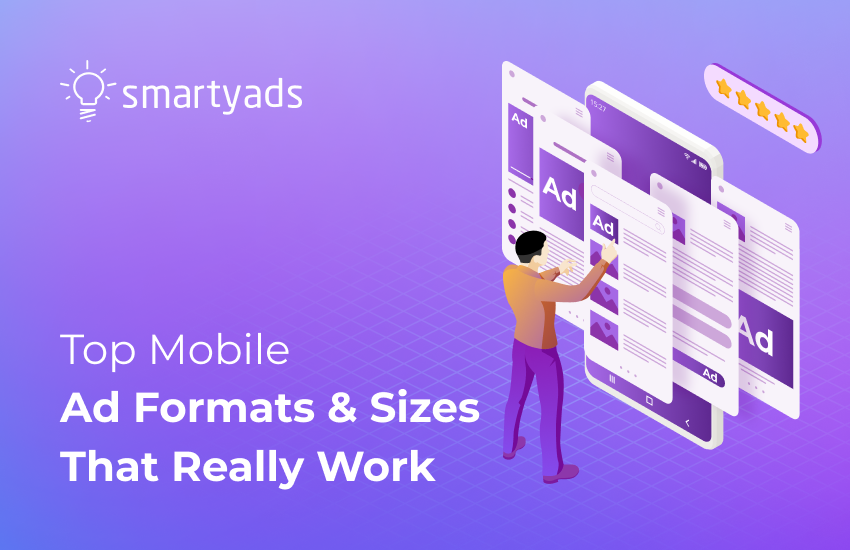Advertising bridges consumers and brands, and modern technologies make it possible in a cost-effective and less time-consuming way. Advertisers test various tactics, platforms, and formats to make their interactions through mobile ad formats more effective. So, the approaches to mobile rich media ads change now and then.
This constant pursuit of better options for ad campaign optimization factors into experiments with different types of ads, formats, and sizes. That leads to increased investments in digital advertising. Ad spending in the advertising market worldwide is expected to reach US$1,158.00bn in 2025.
What mobile ad formats, mobile ad types, and sizes are advertisers allocating their ad budgets to nowadays?
Key Takeaways:
- Mobile advertising offers a variety of formats — including video, banner, interstitial, native, and rich media — each with distinct strengths and challenges.
- Popular mobile ad sizes in 2025 include 300×250, 320×50, 320×100, 320×480, 300×600, 728×90, 336×280, 336×336, 160×600, and 468×60.
- Short, high-quality creatives, tailored to specific audience segments, drive higher engagement and reduce ad fatigue.
- Optimization best practices include A/B testing, avoiding overly long video ads, ensuring platform quality, and personalizing creatives to audience needs.
- There is no universal best size — performance depends on matching the right format and dimensions to campaign goals, audience behavior, and device type.
- These strategies can be executed and scaled efficiently through SmartyAds DSP, which provides programmatic buying, advanced targeting, and performance analytics to maximize the impact of mobile ad campaigns.

The shift in advertisers' choices of mobile ad formats over the years
Mobile advertising faced massive changes because users' behavior altered drastically. With over 90% of Facebook's ad profits coming from mobile platforms, it's hard to understate the importance of a correctly tuned and robust strategy for mobile ads.
The reality is trickier. No universal, standard, or magic mobile advertising format works perfectly on all types of platforms or devices. In fact, different sources may suggest various specifications and placements.
For instance, while some experts suggest that the best mobile banner ads should be 300*250, the IAB suggests 300*50 and 320*50 (also known as the mobile leaderboard for fixed-size mobile banner ads).
When we talk about standard IAB sizes, there's no need to dig deep into analytics to notice that large mobile banner ad sizes have become prevalent within the past few years.
Let's have a look at the best mobile ad formats and best mobile ad sizes that lead the race in the industry and their strengths and weaknesses for mobile ad campaigns.
Mobile video ads
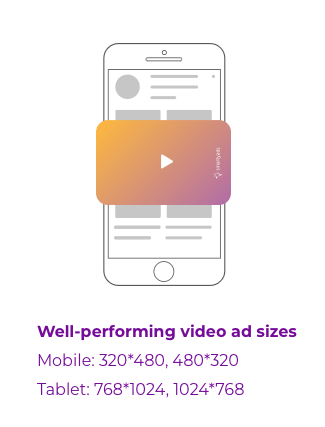 According to HubSpot, video content is at the top of the list of high-performing ad formats, as more than half of users prefer video to other ad formats. That is why 92% of marketers continue to include this ad format in their marketing strategy year over year.
According to HubSpot, video content is at the top of the list of high-performing ad formats, as more than half of users prefer video to other ad formats. That is why 92% of marketers continue to include this ad format in their marketing strategy year over year.
Nevertheless, it's important to understand that not all mobile video ad sizes perform equally well. Common mobile display ad sizes featured in the picture above generate better engagement and enhance average eCPM if the video duration is between 15 to 30 seconds — sufficient time for memorizing the ad without causing user irritation.
The rewarded video ads are considered one of the most popular forms of video marketing. These ads incline users to watch full-screen videos commonly found in mobile games. Advertisers opt for this format as it allows for generating about 46% of revenue.
Pros of video ads for advertisers
- High engagement: Captures attention effectively
- Emotional impact: Evokes strong viewer emotions
- Strong ROI: Drives higher conversions
- Versatile formats: Works across platforms
- Better storytelling: Conveys complex messages
- Sharing potential: Boosts organic reach
- Rich analytics: Provides detailed insights
- Brand recall: Reinforces recognition
Cons of video ads for advertisers
- High costs: It is expensive to produce
- Time-consuming: It takes longer to create
- Ad fatigue: Overuse reduces impact
- Platform limits: Varying specs needed
- Bandwidth issues: It may not load everywhere
- Skippable: Often skipped by viewers
- Accessibility: May lack inclusivity
- Negative feedback: Poor ads harm brands
Mobile banner ads
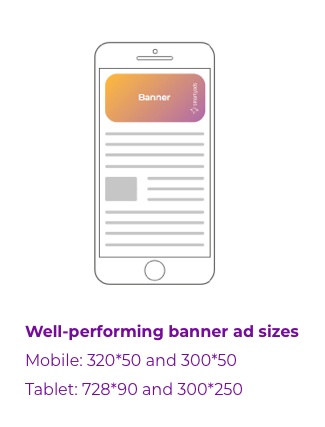
Mobile banner ads are an increasingly popular advertising format. The form of banner ads ranges from animated to static ad units popping up on the user's screen while they use an app or a mobile website.
The banner ads emerge on different spots around the screen of mobile devices, and this mobile ad unit is traditionally the simplest one in terms of implementation.
Most companies and brands use mobile banner ads because they are relatively cheap and effective when ad campaigns aim to raise brand awareness and boost conversions. The average CPMs for mobile banner advertising range between $0.50 and $1.20, making mobile ad banners profitable due to their decent viewability rate.
89% of respondents made a purchase after watching a video on mobile web or in-app.
The best mobile banner ad sizes are 320*50, 300*50 for smartphones, and 728*90, 300*250 for tablets. However, it's important to choose proper sizes and experiment with placement to avoid the so-called banner blindness effect caused by the massive popularity of standard banner ads.
Pros of banner ads for advertisers
- Affordable: Low-cost creation and running
- Wide reach: Visible on many websites
- Targeting: Customizable for audiences
- Trackable: Clear performance data
- Fast setup: Quick to design
- Brand boost: Improves visibility
- Flexible sizes: Fits all placements
- Retargeting: Re-engages past visitors
Cons of banner ads for advertisers
- Ignored: Often overlooked
- Low engagement: Fewer clicks
- Crowded: Competes with other ads
- Annoying: Overuse frustrates users
- Limited info: Conveys little detail
- Blocked: Stopped by ad blockers
- Small sizes: Limits creativity
- Overexposure: Causes banner fatigue
Mobile interstitial ads
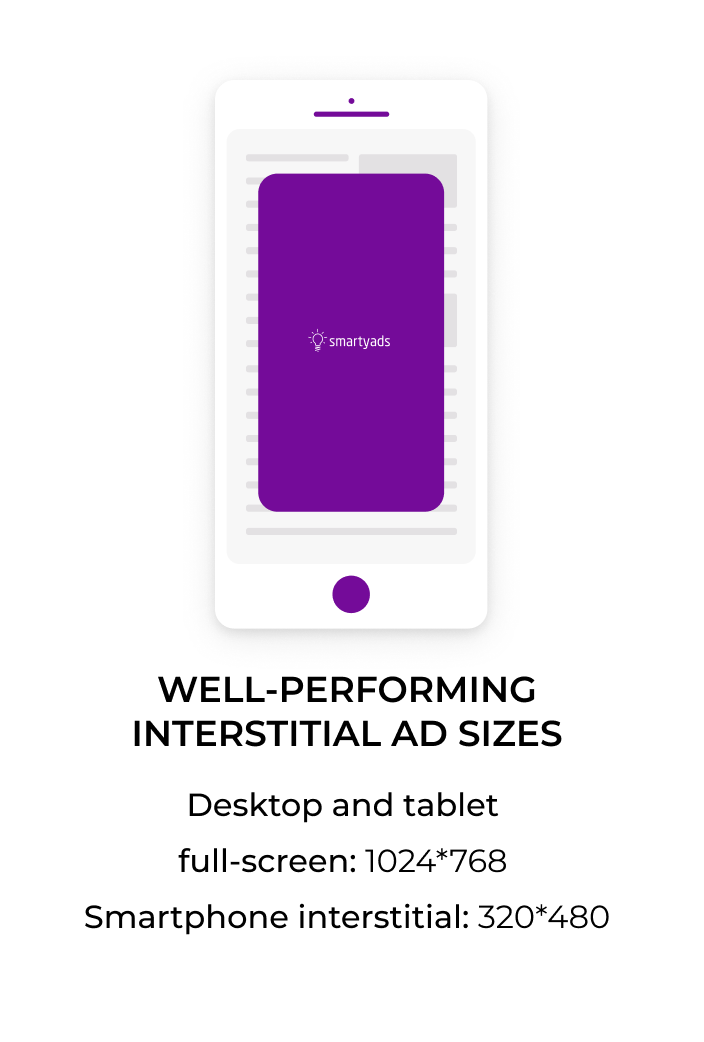
Interstitial ads are widely used in digital advertising. Interstitial ads spring up on mobile web pages but are most common in apps and gaming worlds. Because of their high impression rate, interstitial ads lead to interaction with an ad, which means a wide reach and more conversions.
Interstitial ads offer different dimensions that build an immersive user experience thanks to the new mobile display ad sizes expanding on the whole user screen. These mobile ads pop up when the person opens an app, navigates it, or switches among the pages or modes.
Text, graphics, and rich media creatives are all examples of interstitial units. They come in the form of text, graphics, video, rich media, or playable ads. And they are often resistant to ad blockers on mobile devices, making them more productive in generating conversions.
Because interstitial mobile units have the propensity to compromise user experience, they should be carefully built into the app to prevent hampering user flow. According to Google, they should be "displayed at natural moments in an app's flow, such as when switching between tasks or between stages in a mobile game".
Mobile interstitial ad sizes are usually 320*480 or 1024*768 pixels. With this, interstitial ads cover the user's full screen, catching attention at best. They can, however, result in a non-intrusive advertising strategy if executed clumsily. Ensure that the ad placement and timing do not obstruct user flow.
Pros of interstitial ads for advertisers
- High visibility: Full-screen impact
- Better engagement: Hard to ignore
- Effective for conversions: Drives strong results
- Versatile: Works across devices and apps
Cons of interstitial ads for advertisers
- Intrusive: Can disrupt user experience.
- Skip option: May be dismissed quickly.
- Ad fatigue: Overuse annoys users.
- Compliance: Needs careful placement to meet guidelines.

Native advertising
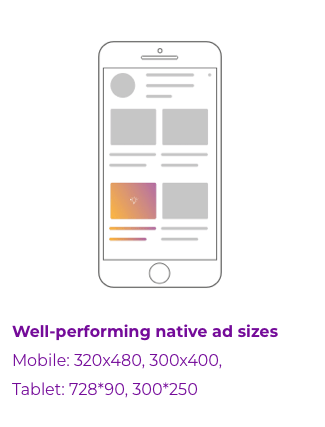
Native ads are easily integrated display advertising ad units. This type of ad belongs to the list of formats advertisers often use to engage with their target audiences. They don't heavily affect the user's comfort because they are harmonized with the rest of the textual or video content.
Furthermore, this form of advertisement is highly related to the content on a website, blog, or app. As a result, your viewers will be more comfortable viewing published ads because they are interested in them.
According to the data, users are 25% more inclined to engage with native marketing content than a banner ad.
This ad format is often called the best mobile ad format due to its proven efficiency in generating 53% more views than a banner ad. In fact, a third of users (32%) report being ready to share the native marketing content with friends or relatives because those mobile advertising formats are known to be often confused with the actual website content. Thus, native is a very popular mobile ad format.
Native marketing content has a higher click-through rate than a traditional ad, which means that advertisers gain more conversions, clicks, views, or other activities if they choose an inventory in line with their niche.
Pros of native ads for advertisers
- Seamless integration: Matches platform content
- Higher engagement: Feels less intrusive
- Better trust: Users perceive them as credible
- Versatile: Fits various formats and platforms
- Improved click-through rates: Drives better interaction
Cons of native ads for advertisers
- Time-consuming: Requires custom content
- Costly: Can be more expensive to produce
- Transparency issues: Users may feel deceived
- Limited scalability: Needs platform-specific designs
- Performance measurement: Harder to track compared to standard ads
Mobile rich media ads
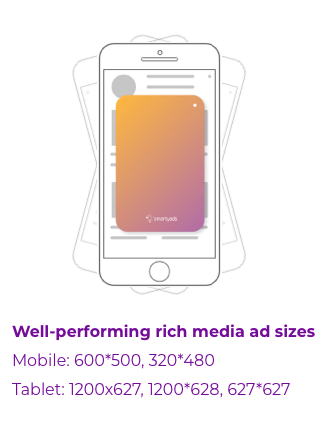
A rich media ad is a combination of several interactive elements designed to make an ad responsive. Rich media incorporates a variety of beautiful and engaging content types, such as images, videos, graphics, animations, etc. They're made to stimulate user action.
Unlike the typical banner ad, rich media content is not static and adapts to different mobile screen sizes. Advertisers can choose a placement for this ad format across a webpage and expand, minimize, and resize it.
Rich media advertising formats exist within the app ecosystem and on website versions adapted for a mobile screen. These ads have a fluid design that adapts to the user's screen and mobile device motions, enabling advertisers to reach broader audiences.
Standard and drop-down rich media mobile ad units are considered the most popular among advertisers. However, different formats of rich media ads are designed to achieve different purposes.
Rich media advertising increases user interaction, improves brand recall, and enhances message recall. This elicits impression growth and increases ad revenue from your display advertising campaigns.
Pros of rich media ads for advertisers
- Highly engaging: Interactive and dynamic
- Creative flexibility: Allows unique designs
- Better recall: Increases brand awareness
- Boosts conversions: Encourages user action
- Multi-device compatibility: Works across platforms seamlessly
Cons of rich media ads for advertisers
- Higher costs: More expensive to produce
- Complex development: Requires technical expertise
- Slower load times: This can affect user experience
- Ad blockers: Often targeted by blockers
- Performance monitoring: Tracking can be more complicated
Top 10 mobile ad sizes & formats
The popularity of mobile banner ads can change with time and is often influenced by user preference and popular screen sizes at a particular time. However, standard banner ads have remained the same for years.
As of now, the following mobile banner ads sizes engage users the best.
300*250 pixels
The ad slot of 300*250 pixels is also one of the best mobile ad sizes. This ad size is called a medium rectangle, and many advertisers create their mobile ad campaigns with this size in mind. Medium rectangles allow advertisers to enhance their ad campaigns.
336*280
This ad type is similar to the 300*250 rectangle size with little difference. The similarities between both mobile ad sizes make them popular among advertisers.
320*100
Google recognizes the 320*100 size as one of the most standard mobile ad sizes. It is often referred to as a large mobile banner and is served by the Google display network. It is tailored to fit the dimensions of most devices. While the large mobile banner is efficient, placing your ads on the spot with other large mobile banners may frustrate users.
320*50
The 320*50, or the mobile leaderboard, has been one of the best ad sizes for years. Like the 320*100 banner, a mobile leaderboard is also designed to suit the screen size of most mobile devices. This ad size helps to reduce the possibility of intrusive advertising.
320*480
Expandable ads have become more popular in recent times. Plus, they are more user-friendly and less intrusive. The 320*480 resolution supports expandable ads perfectly and suits most devices. They also enhance rich media ad results.
Learn more about new opportunities with SmartyAds mobile ad formats.
300*600
The 300x600 ad size, also called a half-page or double rectangle, offers high visibility and impact. Its large format is ideal for showcasing engaging content, driving user attention, and boosting ad performance.
468*60
The 468x60 ad size, known as the Tablet or Full Banner, is compact yet effective for increasing brand visibility. This is one of the mobile app ad sizes that works well in headers and footers, offering seamless integration without disrupting user experience.
160*600
The 160x600 Wide Skyscraper is a vertical ad format designed for sidebars. Its slim yet tall design ensures high visibility, making it ideal for engaging users without occupying excessive page space.
728*90
The 728x90 Standard Leaderboard is a prominent horizontal ad format often placed at the top of web pages. It delivers excellent visibility, making it ideal for driving impressions and engaging audiences effectively.
336*336
The 336x336 Square Format is a versatile ad size that fits seamlessly within content. Its balanced dimensions make it effective for engaging users, delivering impactful visuals, and driving higher click-through rates.
Optimization recommendations for advertisers
In trying to increase mobile ad revenue, advertisers should improve their approaches and avoid some common mistakes. One negative impression made through the ad may cross out all the endeavors to hit the customers' hearts.
What dos and don'ts should advertisers follow to achieve their marketing goals?
Improve the quality of ad creative
Be concerned about the quality of ad creatives and the messages they convey. Users are more likely to engage with high-quality ad media that relates to their values and needs.
That is why advertisers should avoid excessively intense colors, low-quality visuals, and creatives overloaded with text and messages that don't align with the company's vision and norms.
When telling your audience about the product and its features, keep messages short and emotionally appealing while ensuring your visuals are eye-catching. Ad media that isn't up to these factors has a significant negative impact on the brand reputation and desired result.
Avoid generic ads
Give a personal touch to your mobile banner ads, in-app ads, or other types of advertising you display to the audience. Address your consumers directly and make them feel special. As a result, you can boost engagement because personalization converts better than non-specific video ads or banners.
In other words, prepare ad creatives for different user segments to reach out to these people and meet their needs. With programmatic advertising opportunities, you can successfully deliver each creative to the right audience by narrowly targeting your consumers based on multiple factors, including gender, location, interests, etc. (Explore which targeting option is best for achieving brand awareness in our article.)
Ward off long video ads
Users leave the page within 20 seconds of their visit, while the attention span is even shorter, averaging 7.5 seconds.
Therefore, opt for short videos. Video ads lasting 3 to 6 seconds are more likely to be watched, and they have no negative impact on users.
Place your ads on trusted platforms
Users spent 6.6 seconds with a mobile ad when it covered 80 percent of the screen. The time spent decreases with the lower percent of the screen cover. This data clearly shows that the proper ad format and the quality of ad inventory influence the audience reach and viewability of your ads.
Whether you work directly with publishers or via ad networks, examine the platform's performance and the audience to get a comprehensive picture of the feasible result for your mobile ad campaign.
Adopt data analysis
Do not place ads randomly and rely only on other's experiences. Test, analyze, draw conclusions, and experiment with each ad format.
If experts say, for example, that video ads or interstitial mobile ads perform better than mobile interstitial ads or rewarded video ads, it doesn't mean that it will work the same way for your product.
You should conduct research and rely on credible data. Find tools and solutions that give you this analysis.
Embrace A/B testing
A/B testing is a method of comparing two options to find out which works better. It would be best to compare various ad placements and formats and how users react to them. This way, you will know which ad types have the most positive ad impressions on an ad campaign.
To sum up
A few years ago, mobile banner ads were only displayed in banner format. Today, there are multiple display formats. In the future, mobile advertising will only become more creative and innovative. More formats will emerge as the industry advances, powered by cutting-edge solutions.
That's why advertisers should spot new display trends and adapt them to their marketing goals. While doing this, it is crucial to consider what works best for your audience so you don't scare them away.
Studying your audience's behavioral patterns and preferences while interacting with your creative across applications or websites will hint at the right ad display formats.
The truth is, there is no specific best, but rather a range of high-performing mobile ad sizes to perfectly fit your metrics and advertising objectives. Video ads, banner ads, interstitials, rich media, and mobile native ad formats are in high demand, so it's time to benefit from them.
Register at SmartyAds DSP to benefit from the technologically powered solution!
FAQ
Click-through rate, engagement metrics, conversion rate, and return on ad spend are used to analyze the performance of various ad formats.
Responsive design principles enable ads to adapt to different screen sizes and resolutions. This ensures that ads function and play off properly across the screens on various mobile devices.
Immersive AR (Augmented Reality) and VR (Virtual Reality) ad experiences and interactive storytelling formats are the latest industry trends. However, trends aren't the most important thing in advertising, but the mobile ad formats that align with specific campaign goals and are able to strike a target audience.

